Cheboksary
| Cheboksary (English) Чебоксары (Russian) Шупашкар (Chuvash) |
|
|---|---|
| — Inhabited locality — | |
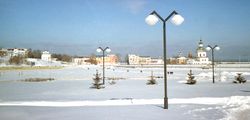 |
|
.svg.png) Location of the Chuvash Republic in Russia |
|
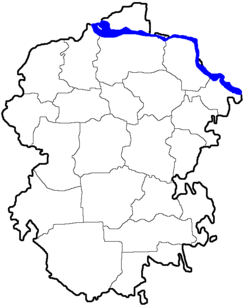 Cheboksary
|
|
| Coordinates: | |
.png) |
|
| Holiday | Third Sunday of August |
| Administrative status | |
| Country | Russia |
| Federal subject | Chuvash Republic |
| Capital of | Chuvash Republic |
| Municipal status | |
| Urban okrug | Cheboksary Urban Okrug |
| Head | Nikolay Yemelyanov |
| Representative body | City Assembly of Deputies |
| Statistics | |
| Population (2002 Census) | 451,329 inhabitants[1] |
| - Rank | 39th |
| Time zone | MSK/MSD (UTC+3/+4) |
| Founded | 1469 |
| Postal code(s) | 428xxx |
| Dialing code(s) | +7 8352 |
| Official website | |
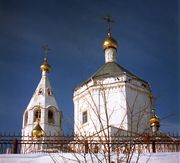
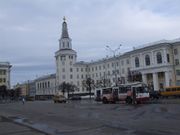
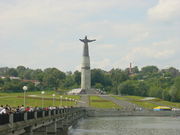
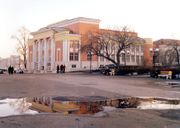
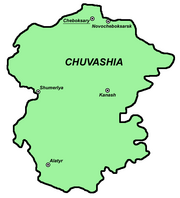
Cheboksary (Russian: Чебокса́ры; Chuvash: Шупашкар, Šupaškar/Shupashkar) is a city and the capital of the Chuvash Republic, Russia. It is a port on the Volga River. Population: 453,700 (2004 est.); 440,621 (2002 Census);[1] 419,592 (1989 Census).[2] There is a satellite city Novocheboksarsk about six kilometers east with a population of 125,857 (2002 Census).[1]
Cheboksary is divided into three city districts: Kalininsky, Leninsky, and Moskovsky.
Contents |
History
Cheboksary was first mentioned in written sources in 1469, when Russian soldiers passed here on their way to the Khanate of Kazan. According to archaeological excavations, however, the area had been populated considerably earlier. The site hosted a Bulgarian city of Veda Suvar, which appeared after Mongols defeated major Volga Bulgarian cities in 13th century. During Khanate period the town is believed by some to have had a Turkic (probably, Tatar) name Çabaqsar and that the current Russian and English names originate from it. However, in maps by European travelers it was marked as Cibocar (Pizzigano, 1367), Veda-Suar (Fra Mauro, 1459). Shupashkar, the Chuvash name literally means the "fortress" of the Chuvash.
In 1555, the Russians built a fortress and established a settlement here. In 1625, there were 458 soldiers quartered in Cheboksary, and in 1646 there were 661 males living in the settlement. At the end of the 17th century, Cheboksary was regarded as a major commercial city of the Volga region, and in 1781 it received the status of a city of the Kazan province. In the beginning of the 19th century the population was about 5500, the town had a sawmill and several small manufactures.
Cheboksary also was noted for its 25 churches and four monasteries, and Cheboksary bells were known in London and Paris.
In the 16th and the first half of the 17th century the Vvedensky cathedral, four monasteries and eighth churches had been built, in the 18th century the stone buildings of treasury and archive, magistracy, court, and 10 churches. In 1880 here were counted 783 houses (33 of them from stone), 91 stores, three schools, two hospitals and a bank.
In the beginning of the 20th century, 5,100 people lived in Cheboksary. In 1965, the population was 163,000.
Culture
Like many Russian cities, Cheboksary possesses many cultural opportunities. There is an opera-ballet theater, a philharmonic orchestra, and numerous theaters (showing productions in both Russian and Chuvash languages). However, a very popular gathering place for the locals is the recently completed zaliv (bay), beautifully situated in the middle of the city. There people gather to stroll, visit cafes, and socialize. Cheboksary also has beautiful boardwalks and beaches along the Volga River, where people swim in the summer. There are also a number of heated pools, health clubs, and museums (including Russia's only beer museum).[3]
Education
Educational institutions include the Chuvash State University, Chuvash State Agriculture Academy, the Chuvash State Pedagogical University, and the Cheboksary Cooperative Technical School.
Economy
Cheboksary is located near a hydro-electric power station generating up to 1,404 MW, with a reservoir of 2,274 km2 (878 sq mi). Cheboksary is the location of the headquarters of the Concern Tractor Plants, Russia's leading machine building company and one of the largest heavy mechanical engineering companies in the world.[3][4]
Transportation
The Cheboksary Airport (IATA CSY, ICAO UWKS, international airport since 1995) receives both cargo and passenger aircraft of practically all types and sizes. There are regularly scheduled flights to Moscow and other destinations. Chuvashia Airlines is based at this airport. Cheboksary is located about a four-hour drive from Nizhny Novgorod, a city with international air connections through Lufthansa.[3]
Because the Volga River runs through Chuvashia, Cheboksary is a frequent stop on the many boat tours that travel along the major cities up and down the Volga. To the south, Volgograd, Rostov-on-Don, Astrakhan, the Caspian Sea, and Black Sea are directly reachable. To the west, the Volga River connects Cheboksary with Nizhny Novgorod, Yaroslavl, Moscow, and the northern regions of Russia. By using river-sea vessels, it is possible to take cargo from Chuvash riverports all the way to Saint Petersburg, Novorossiysk (on the Black Sea), Astrakhan, and ports situated on the Danube river. However, the river is frozen from December to April.[3]
Public transportation within Cheboksary is among the best in Russia. An extensive system of trolleybuses, autobuses, and minibuses covers the city, providing quick, convenient access to all parts of the city. For those who prefer taxis, there are several taxi agencies available, but the favorite means of transportation among locals are so-called "Gypsy" cabs. In Russia, anybody who owns a car is potentially a taxi. This can be a convenient way to get around but it is also potentially dangerous. Official taxis cost less than two dollars for travel between most points within the city.[3]
International relations
Twin towns — Sister cities
Cheboksary is twinned with:

Also Partnerships are shown with:
Notes and references
- ↑ 1.0 1.1 1.2 Федеральная служба государственной статистики (Federal State Statistics Service) (2004-05-21). "Численность населения России, субъектов Российской Федерации в составе федеральных округов, районов, городских поселений, сельских населённых пунктов – районных центров и сельских населённых пунктов с населением 3 тысячи и более человек (Population of Russia, its federal districts, federal subjects, districts, urban localities, rural localities—administrative centers, and rural localities with population of over 3,000)" (in Russian). Всероссийская перепись населения 2002 года (All-Russia Population Census of 2002). Federal State Statistics Service. http://perepis2002.ru/ct/html/TOM_01_04_1.htm. Retrieved 2009-08-19.
- ↑ "Всесоюзная перепись населения 1989 г. Численность наличного населения союзных и автономных республик, автономных областей и округов, краёв, областей, районов, городских поселений и сёл-райцентров. (All Union Population Census of 1989. Present population of union and autonomous republics, autonomous oblasts and okrugs, krais, oblasts, districts, urban settlements, and villages serving as district administrative centers.)" (in Russian). Всесоюзная перепись населения 1989 года (All-Union Population Census of 1989). Demoscope Weekly (website of the Institute of Demographics of the State University—Higher School of Economics. 1989. http://demoscope.ru/weekly/ssp/rus89_reg.php. Retrieved 2007-12-13.
- ↑ 3.0 3.1 3.2 3.3 3.4 Steven Brown and Olin Lagon (2001-06). "Economic Overview of the Republic of Chuvashia". United States Peace Corps Business Development Volunteers in Chuvashia. http://www.bisnis.doc.gov/bisnis/bisdoc/0106Chuvashia.htm. Retrieved 2009-01-10.
- ↑ "Company Profile". Concern Tractor Plants. http://www.tplants.com/en/company/. Retrieved 2009-07-14.
- ↑ Cheboksary will be soon twinned with Rundu
External links
- Cheboksary travel guide from Wikitravel
- Map of Cheboksary and environs
- Photos from Cheboksary
- Blog and Fotos of Cheboksary
|
|||||
|
|||||||||||||||||